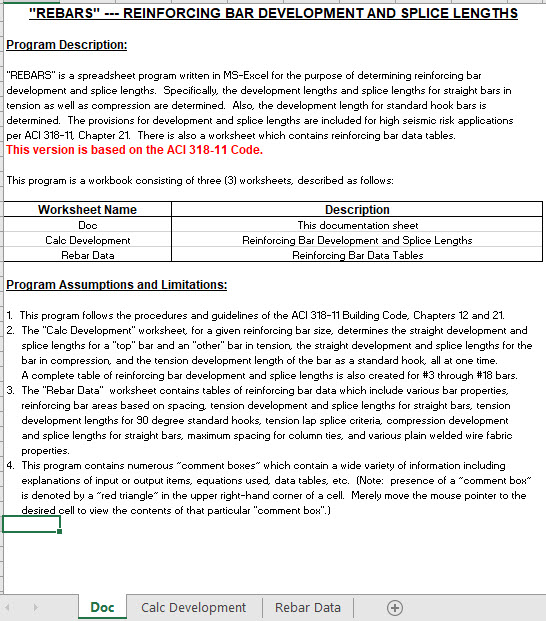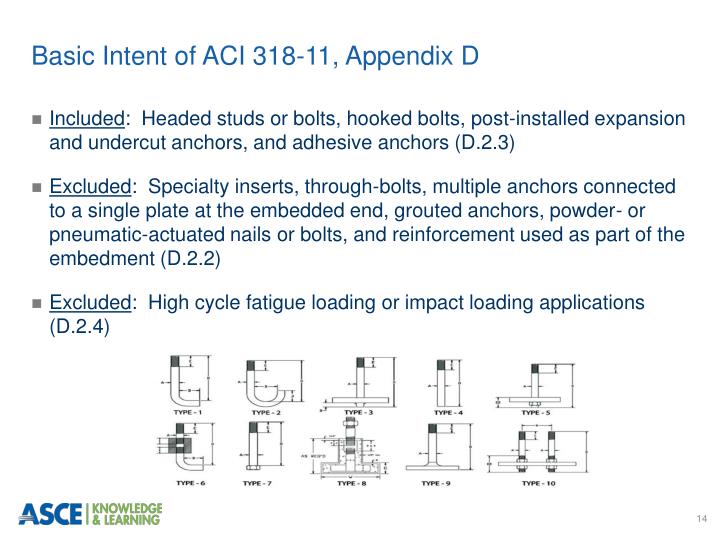-
Aci 318 Code Free Download카테고리 없음 2021. 5. 20. 19:10
ACI 318M-14 Building Code Requirements for Structural Concrete (ACI 318M-14) and Commentary (ACI 318RM-14) Reported by ACI Committee 318 An ACI Standard www.mirjalili.net A-PDF Watermark DEMO: Purchase from www.A-PDF.com to remove the watermark. Lifting hooks in a form unit can be designed to serve also as anchors or shear connectors. 7.7.2.4 Code requirements-Precast concrete forms used in composite design with cast-in-place concrete in buildings should be designed in accordance with ACI 318. 7.7.3-During and after concreting 7.7.3.1 Vibration-Thorough consolidation of site-cast. ACI 318-11 was adopted as a standard of the American Concrete Institute May 24, 2011, to supersede ACI 318-08 in accordance with the Institute’s standardization procedure and was published August 2011. A complete metric companion to ACI 318 has been developed, 318M; metric equivalents are provided only in Appendix F of this document.
Mutual Materials
- Bellevue
- (425) 452-2300
If you have questions about specific products or services we provide, please don’t hesitate to contact us.

INTRODUCTION
Concrete masonry fences and garden walls are used to fulfill a host of functions, including privacy and screening, security and protection, ornamentation, sound insulation, shade and wind protection.
In addition, concrete masonry provides superior durability, design flexibility and economy. The wide range of masonry colors and textures can be used to complement adjacent architectural styles or blend with the natural landscape.

Because fences are subjected to outdoor exposure on both sides, selection of appropriate materials, proper structural design and quality workmanship are critical to maximize their durability and performance.
STRUCTURAL DESIGN
Masonry fences are generally designed using one of five methods:
- as cantilevered walls supported by continuous footings;
- as walls spanning between pilasters, that are, in turn, supported by a footing pad or caisson;
- as walls spanning between wall returns that are sufficient to support the wall;
- as curved walls with an arc-to-chord relationship that provides stability; or
- as a combination of the above methods.
This TEK covers cases (a) and (d) above, based on the provisions of the 2003 and 2006 editions of the International Building Code (refs. 1, 2). Although fences up to 6 ft (1,829 mm) high do not require a permit (refs. 1 and 2, Ch.1), this TEK provides guidance on design and construction recommen- dations. Fences designed as walls spanning between pilasters (case b) are covered in TEK 14-15B, Allowable Stress Design of Pier and Panel Highway Sound Barrier Walls (ref. 3). In addition, fences can be constructed by dry-stacking and surface bonding conventional concrete masonry units (see ref. 4), or by utilizing proprietary dry-stack fence systems.
Figure 1—Typical Construction Requirements for a Cantilevered Fence
CANTILEVERED FENCE STRUCTURAL DESIGN
Tables 1, 2 and 3 provide wall thickness and vertical reinforcement requirements for cantilevered walls for three lateral load cases: lateral load, w ≤ 15 psf (0.71 kPa), 15 < w ≤ 20 psf (0.95 kPa), and 20 < w ≤ 25 psf (1.19 kPa), respectively. For each table, footnote A describes the corresponding wind and seismic conditions corresponding to the lateral load, based on Minimum Design Loads for Buildings and Other Structures, ASCE 7 (ref. 5).
Assumptions used to develop Tables 1, 2 and 3 are:
- strength design method
- except as noted, designs comply with both the 2003 and 2006 International Building Code,
- running bond masonry,
- ASTM C 90 (ref. 6) concrete masonry units,
- specified compressive strength of masonry, f’m = 1,500 psi (10.3 MPa)
- ASTM C 270 (ref. 7) mortar as follows: Type N, S or M portland cement /lime mortar or Type S or M masonry cement mortar (note that neither Type N nor masonry cement mortar is permitted to be used in SDC D),
- ASTM C 476 (ref. 8) grout,
- Grade 60 reinforcing steel, reinforcement is centered in the masonry cell,
- depth from grade to top of footing is 18 in. for 4- and 6-ft (457 mm for 1.2- and 1.8-m) high fences; 24 in. for 8-ft (610 mm for 2.4-m) high fences, and
- reinforcement requirements assume a return corner at each fence end with a length at least equal to the exposed height. Where fence ends do not include a return, increase the design lateral load on the end of the fence (for a length equal to the exposed height) by 5 psf (34.5 kPa).
Table 1—Cantilevered Fences Subject to Lateral Loads up to 15 psf (0.71 kPa)
Table 2—Cantilevered Fences Subject to Lateral Loads up to 20 psf (0.95 kPa)

Table 3—Cantilevered Fences Subject to Lateral Loads up to 25 psf (1.19 kPa)
FOOTINGS
For cantilevered walls, the footing holds the wall in position and resists overturning and sliding due to lateral loads. Dowels typically extend up from the footing into the wall to transfer stresses and anchor the wall in place. Dowels should be at least equal in size and spacing to the vertical fence reinforcement. The required length of lap is determined according to the design procedure used and type of detail employed. For the design conditions listed here, the No. 4 (M#13) reinforcing bars require a minimum lap length of 15 in. (381 mm), and the No. 5 (M#16) bars require a minimum lap length of 21 in. (533 mm). Refer to TEK 12-6, Splices, Development and Standard Hooks for Concrete Masonry (ref. 9) for detailed information on lap splice requirements.
Footings over 24 in. (610 mm) wide require transverse reinforcement (see footnotes to Table 4). For all footings, the hook should be at the bottom of the footing (3 in. (76 mm) clearance to the subgrade) in order to develop the strength of the bar at the top of the footing.
The footing designs listed in Table 4 conform with Building Code Requirements for Reinforced Concrete, ACI 318 (ref. 10). Note that concrete for footings placed in soils containing high sulfates are subject to additional requirements (refs. 1, 2).
SERPENTINE WALLS
Serpentine or “folded plate” wall designs add interesting and pleasing shapes to enhance the landscape. The returns or bends in these walls also provide additional lateral stability, allowing the walls to be built higher than if they were straight.
Serpentine and folded plate walls are designed using empirical design guidelines that historically have proven successful over many years of experience. The guidelines presented here are based on unreinforced concrete masonry for lateral loads up to 20 psf (0.95 kPa). See Table 2, footnote A for corresponding wind speeds and seismic design parameters.
Design guidelines are shown in Figure 2, and include:
- wall radius should not exceed twice the height,
- wall height should not exceed twice the width (or the depth of curvature, see Figure 2),
- wall height should not exceed fifteen times the wall thickness, and
- the free end(s) of the serpentine wall should have additional support such as a pilaster or a short-radius return.
A wooden template, cut to the specified radius, is helpful for periodically checking the curves for smoothness and uniformity. Refer to TEK 5-10A, Concrete Masonry Radial Wall Details (ref. 11) for detailed information on constructing curved walls using concrete masonry units.
CONSTRUCTION
All materials (units, mortar, grout and reinforcement) should comply with applicable ASTM standards. Additional material requirements are listed under the section Cantilevered Fence Structural Design, above.
To control shrinkage cracking, it is recommended that horizontal reinforcement be utilized and that control joints be placed in accordance with local practice. In some cases, when sufficient horizontal reinforcement is incorporated, control joints may not be necessary. Horizontal reinforcement may be either joint reinforcement or bond beams. See TEK 10-1A, Crack Control in Concrete Masonry Walls, and TEK 10-2B, Control Joints for Concrete Masonry Walls – Empirical Method (refs. 12, 13) for detailed guidance.
In addition, horizontal reinforcement in the top course (or courses if joint reinforcement is used) is recommended to help tie the wall together. For fences, it is not structurally necessary to provide load transfer across control joints, although this can be accomplished by using methods described in TEK 10-2B if deemed necessary to help maintain the fence alignment.
Copings provide protection from water penetration and can also enhance the fence’s appearance. Various materials such as concrete brick, cast stone, brick and natural stone are suitable copings for concrete masonry fences. Copings should project at least ½ in. (13 mm) beyond the wall face on both sides to provide a drip edge, which will help keep dripping water off the face of the fence. In cases where aesthetics are a primary concern, the use of integral water repellents in the masonry units and mortar can also help minimize the potential formation of effl orescence.
References
- 2003 International Building Code. International Code Council, 2003.
- 2006 International Building Code. International Code Council, 2006.
- Allowable Stress Design of Pier and Panel Highway Sound Barrier Walls, NCMA TEK 14-15B. National Concrete Masonry Association, 2004.
- Design and Construction of Dry-Stack Masonry Walls, TEK 14-22. National Concrete Masonry Association, 2003.
- Minimum Design Loads for Buildings and Other Structures, ASCE 7-02 and ASCE 7-05. American Society of Civil Engineers, 2002 and 2005.
- Standard Specification for Loadbearing Concrete Masonry Units, ASTM C 90-01a and C 90-03. ASTM International, Inc., 2001 and 2003.
- Standard Specification for Mortar for Unit Masonry, ASTM C 270-01a and C 270-04. ASTM International, Inc., 2001 and 2004.
- Standard Specification for Grout for Masonry, ASTM C 476-01 and C 476-02. ASTM International, Inc., 2001 and 2002.
- Splices, Development and Standard Hooks for Concrete Masonry, TEK 12-6. National Concrete Masonry Association, 2007.
- Building Code Requirements for Structural Concrete, ACI 318-02 and ACI 318-05. Detroit, MI: American Concrete Institute, 2002 and 2005.
- Concrete Masonry Radial Wall Details, TEK 5-10A. National Concrete Masonry Association, 2006.
- Crack Control in Concrete Masonry Walls, TEK 10-1A. National Concrete Masonry Association, 2005.
- Control Joints for Concrete Masonry Walls – Empirical Method, TEK 10-2B. National Concrete Masonry Association, 2005.
Aci 318 11 Free Pdf
NCMA and the companies disseminating this technical information disclaim any and all responsibility and liability for the accuracy and the application of the information contained in this publication.